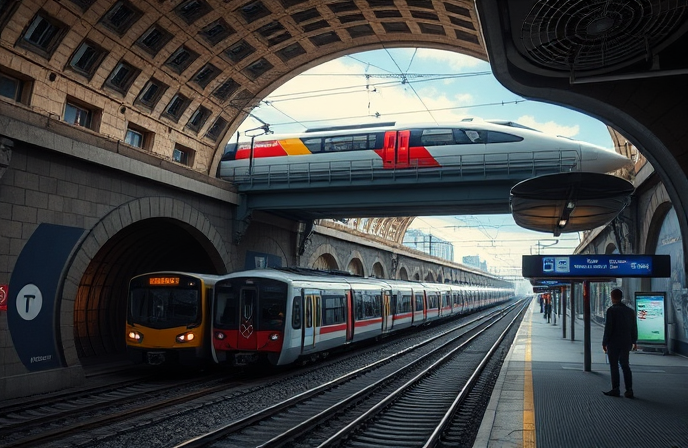Modernizing Brazil’s Railways: VLI’s Connectivity Upgrade

Modernizing Brazilian Railway Communication: A Case Study of VLI Logistica’s Connectivity Enhancement
The Brazilian railway system, a crucial artery for the nation’s economy, is undergoing a significant transformation. This article explores a pivotal initiative undertaken by VLI Logistica (a leading multimodal logistics company), in partnership with Globalsat Brasil and Viasat, to dramatically improve locomotive connectivity across a substantial portion of their network. This project focuses on upgrading communication infrastructure, not merely for operational efficiency but also to integrate advanced safety technologies and pave the way for future automation. The modernization strategy implemented involves a hybrid satellite and LTE (Long Term Evolution) communication system designed to address the unique challenges of Brazil’s vast and diverse geography, ensuring reliable and rapid communication across 1,800 km of track spanning São Paulo, Goiás, and Minas Gerais states. The implications extend beyond improved operational efficiency, touching upon enhanced safety protocols, streamlined regulatory compliance, and the potential for future advancements in autonomous train operations. We will analyze the technological solutions employed, the operational benefits realized, and the future potential of this initiative, setting a precedent for modernization across the Brazilian rail sector.
The Need for Enhanced Connectivity
VLI Logistica, operating a fleet of 584 locomotives and 21,000 wagons across ten states and 300 municipalities, relies heavily on efficient communication for its operations. Historically, communication within the rail network faced challenges due to the geographical limitations and the inherent difficulties in establishing consistent connectivity across vast distances in diverse terrains. The limitations of existing systems hindered real-time monitoring of train operations, efficient scheduling, and prompt response to emergencies. This lack of robust and widespread connectivity directly impacted operational efficiency, safety, and overall logistical performance. The lack of standardized IP (Internet Protocol) based data communication for locomotive licensing further complicated regulatory compliance and added administrative burden.
Implementing a Hybrid Satellite and LTE Solution
To overcome these limitations, VLI Logistica, in collaboration with Globalsat Brasil and Viasat, implemented a hybrid satellite and LTE communication solution. This approach leverages the strengths of both technologies: satellite communication provides broad coverage, even in remote areas with limited or no LTE infrastructure, while LTE offers high bandwidth and low latency where available. The hybrid model ensures consistent connectivity across the entire 1,800km network, eliminating communication blind spots. This robust infrastructure is designed to support existing onboard systems while also facilitating the integration of cutting-edge technologies, such as Positive Train Control (PTC).
Safety and Operational Improvements with PTC and Beyond
The integration of PTC is a critical aspect of this modernization. PTC is a safety system designed to automatically stop a train before it encounters a hazardous situation, such as a collision or derailment. The reliable communication provided by the hybrid network is essential for the effective functioning of PTC, enhancing overall safety standards. Beyond PTC, the improved connectivity enables real-time monitoring of fleet data, optimizing network management, and reducing transit times. Enhanced communication between control centers and locomotive operators allows for faster response times in emergencies, ensuring critical information reaches the right personnel swiftly.
Standardization and Modernization of Locomotive Licensing
The initiative also tackles the critical issue of locomotive and rail vehicle licensing. By transitioning to IP-based data communication, the project aims to streamline the licensing process, improving efficiency and reducing administrative overhead. This standardization improves regulatory compliance and reduces the risk of delays or operational disruptions associated with outdated licensing procedures. The shift towards digital licensing facilitates data exchange and contributes to a more efficient, transparent, and traceable process.
Conclusion
The collaboration between VLI Logistica, Globalsat Brasil, and Viasat represents a significant step forward in modernizing Brazilian railway operations. The implementation of a hybrid satellite and LTE communication system, combined with the integration of advanced technologies like PTC and standardized IP-based locomotive licensing, delivers substantial benefits across multiple fronts. The project significantly enhances safety by enabling real-time monitoring and automatic train control, improves operational efficiency through optimized network management and reduced transit times, and streamlines administrative processes through modernized licensing procedures. The initiative’s success underscores the importance of strategic partnerships and technological innovation in driving progress within the rail industry. This project serves as a compelling model for other railway operators in Brazil and globally, demonstrating the transformative potential of embracing advanced communication technologies to achieve higher levels of safety, efficiency, and operational excellence. The successful commissioning phase signifies the potential for broader adoption of similar strategies across the Brazilian rail network and offers a glimpse into a future where advanced signaling, automation, and real-time applications can further optimize supply chains and enhance the overall efficiency of freight transport. The future looks bright for Brazilian rail, with this initiative paving the way for further technological advancements and operational improvements.




